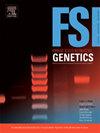The ReAct project: Analysis of data from 23 different laboratories to characterise DNA recovery given two sets of activity level propositions
IF 3.1
2区 医学
Q2 GENETICS & HEREDITY
引用次数: 0
Abstract
The ReAct (Recovery, Activity) project is an ENFSI (European Network of Forensic Science Institutes) supported initiative comprising a large consortium of laboratories. Here, the results from more than 23 laboratories are presented. The primary purpose was to design experiments simulating typical casework circumstances; collect data and to implement Bayesian networks to assess the value (i.e., likelihood ratio) of DNA results given activity level propositions. Two different experimental designs were used to simulate a robbery, where a screwdriver was used to force a door or window. Propositions and case information were chosen following laboratory feedback listing typical casework circumstances (included in the paper). In a direct transfer experiment, the defendant owned and used the screwdriver, but he did not force the door/window in question. An unknown person used the defendant’s stolen screwdriver. In an indirect transfer experiment, the defendant neither owned, saw, nor used the screwdriver, nor did they force the door or window. For the second experiment, given the defence view, the defendant never held the screwdriver. We envisaged the situation where an object manipulated by the defendant (or the defendant himself/herself) would be touched by the unknown offender who would then force the window. It was found for the direct transfer experiment that unless a single contributor profile aligning with the known person’s of interest profile was retrieved, the results did not allow to discriminate between propositions. On the other hand, for the indirect transfer experiment, both single and major contributor profiles that aligned with the person of interest (POI) supported the proposition that the person used the tool rather than an unknown person who had touched an object, when indeed the former was true. There was considerable variation in median recoveries of DNA between laboratories (between 200pg–5ng) for a given experiment if quantities are taken into account. These differences affect the likelihood ratios given activity level propositions. More than 2700 samples were analysed in the course of this study. Two different Bayesian Networks are made available via an open source application written in Shiny R: Shiny_React(). For comparison, all datasets were analysed using a qualitative method categorised into absent, single, major or other given contributors. The importance of standardising methods is emphasised, alongside the necessity of developing new approaches to assign the probability of laboratory-dependent DNA recovery. Freely accessible open databases play a crucial role in supporting these efforts.
ReAct项目:分析来自23个不同实验室的数据,给出两组活动水平命题,以表征DNA恢复。
ReAct(恢复、活动)项目是欧洲法医科学研究所网络(ENFSI)支持的一项倡议,由一个大型实验室联盟组成。这里介绍了超过23个实验室的结果。主要目的是设计模拟典型个案工作环境的实验;收集数据并实施贝叶斯网络来评估给定活动水平命题的DNA结果的价值(即似然比)。两种不同的实验设计被用来模拟抢劫,用螺丝刀撬开门或窗户。命题和案例信息是根据实验室反馈列出的典型案例工作环境(包括在论文中)来选择的。在直接转移实验中,被告拥有并使用了螺丝刀,但他没有强行打开问题中的门/窗。一个身份不明的人用了被告偷来的螺丝刀。在间接转移实验中,被告既没有拥有,也没有看到,也没有使用螺丝刀,也没有强行打开门或窗户。在第二个实验中,根据辩方的观点,被告从未拿过螺丝刀。我们设想的情况是,被告(或被告自己)操纵的物体会被未知的罪犯触摸,然后强行打开窗户。在直接迁移实验中发现,除非检索到与已知的人的兴趣特征相符的单个贡献者的特征,否则结果不允许区分命题。另一方面,在间接转移实验中,单一贡献者和主要贡献者的资料都与感兴趣的人(POI)一致,支持这个人使用工具而不是一个触摸过物体的未知人的命题,而前者确实是正确的。如果将数量考虑在内,在给定的实验中,不同实验室的DNA回收率中值(在200pg-5ng之间)存在相当大的差异。这些差异影响给定活动水平命题的似然比。在这项研究的过程中,超过2700个样本被分析。两个不同的贝叶斯网络通过一个用Shiny R编写的开源应用程序:Shiny_React()提供。为了进行比较,使用定性方法对所有数据集进行分析,将其分为缺席、单一、主要或其他给定贡献者。强调了标准化方法的重要性,以及开发新方法来分配实验室依赖DNA恢复概率的必要性。免费访问的开放数据库在支持这些努力方面起着至关重要的作用。
本文章由计算机程序翻译,如有差异,请以英文原文为准。
求助全文
约1分钟内获得全文
求助全文
来源期刊
CiteScore
7.50
自引率
32.30%
发文量
132
审稿时长
11.3 weeks
期刊介绍:
Forensic Science International: Genetics is the premier journal in the field of Forensic Genetics. This branch of Forensic Science can be defined as the application of genetics to human and non-human material (in the sense of a science with the purpose of studying inherited characteristics for the analysis of inter- and intra-specific variations in populations) for the resolution of legal conflicts.
The scope of the journal includes:
Forensic applications of human polymorphism.
Testing of paternity and other family relationships, immigration cases, typing of biological stains and tissues from criminal casework, identification of human remains by DNA testing methodologies.
Description of human polymorphisms of forensic interest, with special interest in DNA polymorphisms.
Autosomal DNA polymorphisms, mini- and microsatellites (or short tandem repeats, STRs), single nucleotide polymorphisms (SNPs), X and Y chromosome polymorphisms, mtDNA polymorphisms, and any other type of DNA variation with potential forensic applications.
Non-human DNA polymorphisms for crime scene investigation.
Population genetics of human polymorphisms of forensic interest.
Population data, especially from DNA polymorphisms of interest for the solution of forensic problems.
DNA typing methodologies and strategies.
Biostatistical methods in forensic genetics.
Evaluation of DNA evidence in forensic problems (such as paternity or immigration cases, criminal casework, identification), classical and new statistical approaches.
Standards in forensic genetics.
Recommendations of regulatory bodies concerning methods, markers, interpretation or strategies or proposals for procedural or technical standards.
Quality control.
Quality control and quality assurance strategies, proficiency testing for DNA typing methodologies.
Criminal DNA databases.
Technical, legal and statistical issues.
General ethical and legal issues related to forensic genetics.

 求助内容:
求助内容: 应助结果提醒方式:
应助结果提醒方式:


